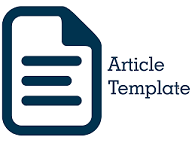Storytelling as A Humanistic Approach in Children Language Stimulation
Abstract
This article discusses the implementation of the storytelling method as humanistic learning in Finland Kindergartens. Language is one aspect of development that is stimulated at an early age. Humanistic learning is learning that optimizes the potential of children as humans. One of the practices of humanistic learning is using storytelling in teaching children. Through storytelling activities, children fulfill their basic needs in self-actualization. In the learning activities seen children in Finland are actively involved in storytelling and the teacher facilitates learning in accordance with the interests and children’s needs.
Keywords: Storytelling, Humanistic Approach, Stimulation in Language Development
Full Text:
PDFReferences
Agra, G., Formiga, N. S., Oliveira, P. S. de, Costa, M. M. L., Fernandes, M. das G. M., & Nobrega, M. M. L. da. (2019). Analysis of the Concept of Meaningful Learning in Light of the Ausubel’s Theory. Rev Bras Enferm, 72(1), 248–255. https://doi.org/http://dx.doi.org/10.1590/0034-7167-2017-0691
Aloni, N. (2011). Humanistic Education: From Theory to Practice. In W. Veugelers (Ed.), ducation and Humanism: Linking Autonomy and Humanity (pp. 35–46). Rotterdam: Sense Publishers.
Arbayah, A. (2013). Model Pembelajaran Humanistik. Dinamika Ilmu, 13(2), 204–220. Retrieved from https://journal.iain-samarinda.ac.id/index.php/dinamika_ilmu/article/view/26/25
Brockett, R. G. (1997). Humanism as an Instructional Paradigm. In C. R. Dills & A. J. Romiszowski (Eds.), Instructional Development Paradigms. Englewood Cliffs, NJ: Educational Technology Publications.
Brodkey, L. (1996). Writing Permitted in Designated Areas Only. Minnesota: University of Minnesota Press.
Chen, P., & Schmidtke, C. (2017). Humanistic Elements in the Educational Practice at a United States Sub-Baccalaureate Technical College. International Journal for Research in Vocational Education and Training (IJRVET), 4(2), 117–145. https://doi.org/10.13152/IJRVET.4.2.2
Elya, M. H. (2020). Pengaruh Metode Bercerita dan Gaya Belajar terhadap Kemampuan Berbicara Anak Usia Dini. Jurnal Obsesi: Jurnal Pendidikan Anak Usia Dini, 4(1), 312–325. https://doi.org/10.31004/obsesi.v4i1.326
Gunstone, R. (2015). Meaningful Learning. In R. Gunstone (Ed.), Encyclopedia of Science Education. Dordrecht: Springer, Dordrecht. https://doi.org/https://doi.org/10.1007/978-94-007-2150-0_121
Miles, M. B., & Huberman, M. A. (1984). Qualitative Data Analysis: A Sourcebook of New Methode. London: SAGE Publications.
Nakata, K. (1972). Business Administration and Education. In C. Weinberg (Ed.), Humanistic Foundations of Education (pp. 227–254). Englewood Cliffs, NJ: Prentice-Hall.
Omrod, E. (2002). Psikologi Pendidikan, Jilid 1. Jakarta: Erlangga.
Rahmawati, Y. (2012). Pengenalan Budaya Melalui Bercerita untuk Anak Usia Dini. Jurnal Pendidikan Anak, 1(1), 72–78. Retrieved from https://journal.uny.ac.id/index.php/jpa/article/download/2908/2422
Rossner, V. F. (1982). A Description and Critique of David P. Ausubel’s Model of Learning. Simon Fraser University. Retrieved from http://summit.sfu.ca/system/files/iritems1/4070/b12748419.pdf
Saepudin, S. (2018). Teori Linguistik dan Psikologi dalam Pembelajaran Bahasa. AL-ISHLAH: Jurnal Pendidikan Islam, 6(1), 100–118. https://doi.org/https://doi.org/10.35905/alishlah.v16i1.738
Sariati, N. P. A., Pudjawan, K., & Antara, P. A. (2018). Pengaruh Metode Bercerita terhadap Kemampuan Sosial Anak Kelompok B pada Taman Kanak-Kanak di Gugus IV. E-Journal Pendidikan Anak Usia Dini Universitas Pendidikan Ganesha, 6(3), 313–322. Retrieved from https://ejournal.undiksha.ac.id/index.php/JJPAUD/article/download/15195/9296
Setiantono, T. (2012). Penggunaan Metode Bercerita bagi Anak Usia Dini di PAUD Smart Little Cilame Indah Bandung. Jurnal EMPOWERMENT, 1(2), 18–23. Retrieved from http://www.e-journal.stkipsiliwangi.ac.id/index.php/empowerment/article/viewFile/611/441
Shahrawat, A., & Shahrawat, R. (2017). Application of Maslow’s Hierarchy of Needs in a Historical Context: Case Studies of Four Prominent Figures. Psychology, 8, 939–954. https://doi.org/10.4236/psych.2017.87061
Smith, M. B. (1969). Social Psychology and Human Values: Selected Essays. Chicago: Aldine.
Taridi, M., Risnita, R., & Hayati, H. (2016). Mengembangkan Kecerdasan Bahasa Anak Usia Dini Melalui Penggunaan Metode Bercerita Bergambar di Taman Kanak-kanak Al-Jamiah Dharma Wanita IAIN STS Jambi. Jurnal Pendidikan Tematik Dikdas, 1(1), 14–22. Retrieved from https://online-journal.unja.ac.id/JPTD/article/download/3075/2302/
Valadares, J. A. C. S. (2013). Concept Maps and the Meaningful Learning of Science. Journal for Educators, Teachers and Trainers, 4, 164–179. Retrieved from https://jett.labosfor.com/index.php/jett/article/download/56/56
Vallori, A. B. (2014). Meaningful Learning in Practice. Journal of Education and Human Development, 3(4), 199–209. https://doi.org/10.15640/jehd.v3n4a18
Veugelers, W. (2011). Education and Humanism: Linking Autonomy and Humanity. Rotterdam: Sense Publishers.
Weinberg, C., & Reidford, P. (1972). Humanistic Educational Psychology. In C. Weinberg (Ed.), Humanistic Foundations of Education (pp. 101–132). Englewood Cliffs, NJ: Prentice-Hall.
Willers, J. C. (1975). Humanistic Education: Concepts, Criteria and Criticism. Peabody Journal of Education, 53, 39–44. https://doi.org/https://doi.org/10.1080/01619567509538047
DOI: https://doi.org/10.24036/kolokium-pls.v8i1.397
Refbacks
- There are currently no refbacks.

